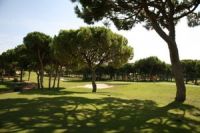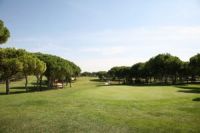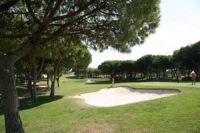Golf in the Algarve
 |
 |
 |
 |
The Algarve is famed for its fantastic and challenging golf courses and here is a selection. Vila Sol This is one of the most highly regarded courses in the Algarve and has played host to the Portuguese Open. A complementary nine-hole loop was recently opened. Situated in the heart of one of the most highly desirable tourist areas in the Algarve, Vila Sol has become a picture postcard of Portuguese golf. The Portuguese Open was held here in both 1992 and 1993. Inaugurated in 1991, this is a typical inland golf course of the British school, designed by Donald Steel and already displaying a high level of maturity. Winding through an immense pinewood, in which fig-trees, oaks and almond-trees also feature, the course is a serious test for any golfer´s strategic skills. The fairways call for accurate driving, and there are several obstacles (lakes and bunkers) that constantly need to be coped with, as well as some really fast greens. Achieving a good final score largely depends on successfully negotiating the first four holes. The fourth hole in the recently-opened nine-hole loop is a par 5 that measures 519 metres and is the longest in the whole course, although several of the new holes are also very challenging. Laguna Situated close to the beautiful Algarvian coast and to the Vilamoura marina, the Laguna golf course represents an enduring challenge to all players because of its strategically placed bunkers and the constant presence of water, as well as its proximity to the ocean. Designed by Joseph Lee, the course makes full use of the marshland near the sea and the layout here is very different to that of the other three Vilamoura courses. The golfer can drive off more confidently because of the greater width of the fairways and the smaller number of trees. Besides the bunkers, water hazards present an almost permanent obstacle. The course is visually intimidating, but as it is not very long, it can be played without too much difficulty. It previously had three loops of nine holes, one of which has now been included in the neighbouring Millennium course. Millenium This is an open course and is a successful blend of a redesigned loop of nine holes that previously belonged to the Laguna Course together with nine holes that were built from scratch. Some holes (from 3 to 7) are bordered by pine trees and have a similar appearance to those at the neighbouring Old Course and Pinhal course. In this more densely wooded area, the fairways are narrower and require greater accuracy, whilst the rest of the course is much easier to play. There are lakes at holes number 4, 17 and 18. The fact that the course has tiger tees (four different teeing-off points for each hole) makes it more competitive, but the wide fairways and greens also make the Millenium Course a pleasant course for golfers of all levels. The Old Course This is the oldest of the four Vilamoura courses and one of the best in the country, enjoying an excellent international reputation due to its recognised quality. Forming part of a luxury tourist development, the Old Course came second in the biennial poll for the best Portuguese golf courses organised by the European Golf magazine (it came first in the special categories for maintenance, services and infrastructures). Frank Pennink wanted to create a course in the Algarve that would remind players of those beautiful but challenging British inland courses. In 1979, it hosted the Portuguese Open and its verdant fairways run through surrounding pine-trees, adding yet another challenge for players. This is a very attractive course with a great variety of holes, perfectly maintained due to a sophisticated new irrigation system and offering the friendly service of its highly-trained staff. The par 3 holes are all different and visually very beautiful, representing the toughest challenge on the course. They require a careful selection of irons and near-perfect stroke play. Over the rest of the course, the trees play a decisive role, lining the edges of the doglegs and punishing any careless strokes. Pinhal This tree-lined course, where the sea forms a constant backdrop, is superbly located in the exclusive tourist and golfing resort of Vilamoura. Inaugurated in 1976, Pinhal Golf Course was designed by the English architect Frank Pennink. In 1985, it was partly redesigned by the famous American architect Robert Trent Jones, who introduced new challenges into the course, creating a wider variety of holes by bringing together two completely different concepts of golf course architecture: British and American. Built in the midst of a beautiful pinewood with panoramic views over the sea, the course calls for great accuracy in the approach shots. Hole number 17, a 502-metre par 5 when played from the championship tee, offers a good chance for a birdie (or even an eagle) to those players who are willing to risk driving over the out-of-bounds area to the right, thereby drastically shortening the accentuated dogleg fairway. The Portuguese Ladies Open was held here in 1988 and there are now three other excellent courses all within a one-kilometre radius (Old Course, Laguna and Millenium). Victoria The previous owners invested 18 million euros in Oceânico's Victoria Golf Club, designed by Arnold Palmer, one of the greatest legends of the sport. This was the most ambitious golf project in Portugal, and was aimed at being one of the best golf complexes in the whole of Europe. The Victoria Clube de Golfe will be the fifth at Vilamoura and the most exclusive one at the resort, making it ideal to became the Algarve's and Portugal's major venue for top international tournaments. Palmer, whose design company has planned some 500 layouts worldwide, compiled the Victoria course project, and Southern Golf, Europe's largest golf course builder, was awarded the construction contract. Oceânico's Victoria Golf Course is an 18-hole, par 72 championship layout, measuring 6.560 meters (7,105 yards) from the back tees. Several man-made lakes provide hazards for the players and also serve as water reservoirs for irrigation. |
